Abstract
After light UV irradiation (5,000 to 10,000 ergs/mm2) “complete” and “defective” simian virus 40 (SV40) showed an enhancement of oncogenic transformation capacity in Syrian hamster kidney cells in vitro up to 180 and 270% of the controls, respectively. Simultaneously with the enhancement of transformation, an increase in T-antigen induction was observed in CV-1 cells infected with light UV-irradiated SV40; infectivity, however, was correspondingly reduced by 1 log10. After strong UV irradiation (10,000 to 80,000 ergs/mm2) of “complete” and “defective” SV40, transformation capacity in vitro proved to be the most resistant viral function. It was only slightly reduced in comparison with a 4 to 5 log10 reduction of infectivity. T-antigen induction of SV40 was also equally resistant to strong UV irradiation. We found no evidence of “multiplicity reactivation” involved in the high resistance of transformation capacity of SV40 after UV irradiation. Syrian hamster kidney cells transformed in vitro by UV-irradiated SV40 contained the SV40-specific T-antigen and showed the same morphology and growth characteristics as cells transformed by non-irradiated “complete” or “defective” SV40. They induced malignant tumors after subcutaneous inoculation into Syrian hamsters.
Full text
PDF
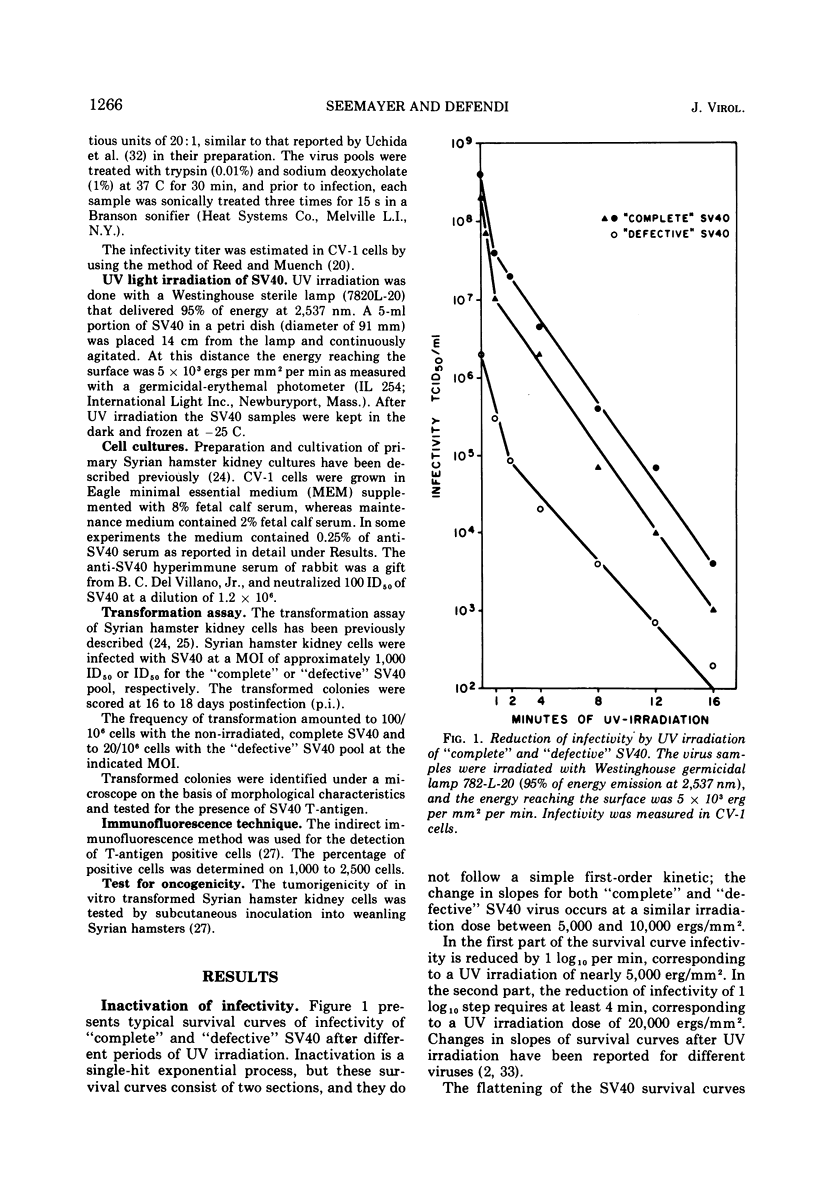
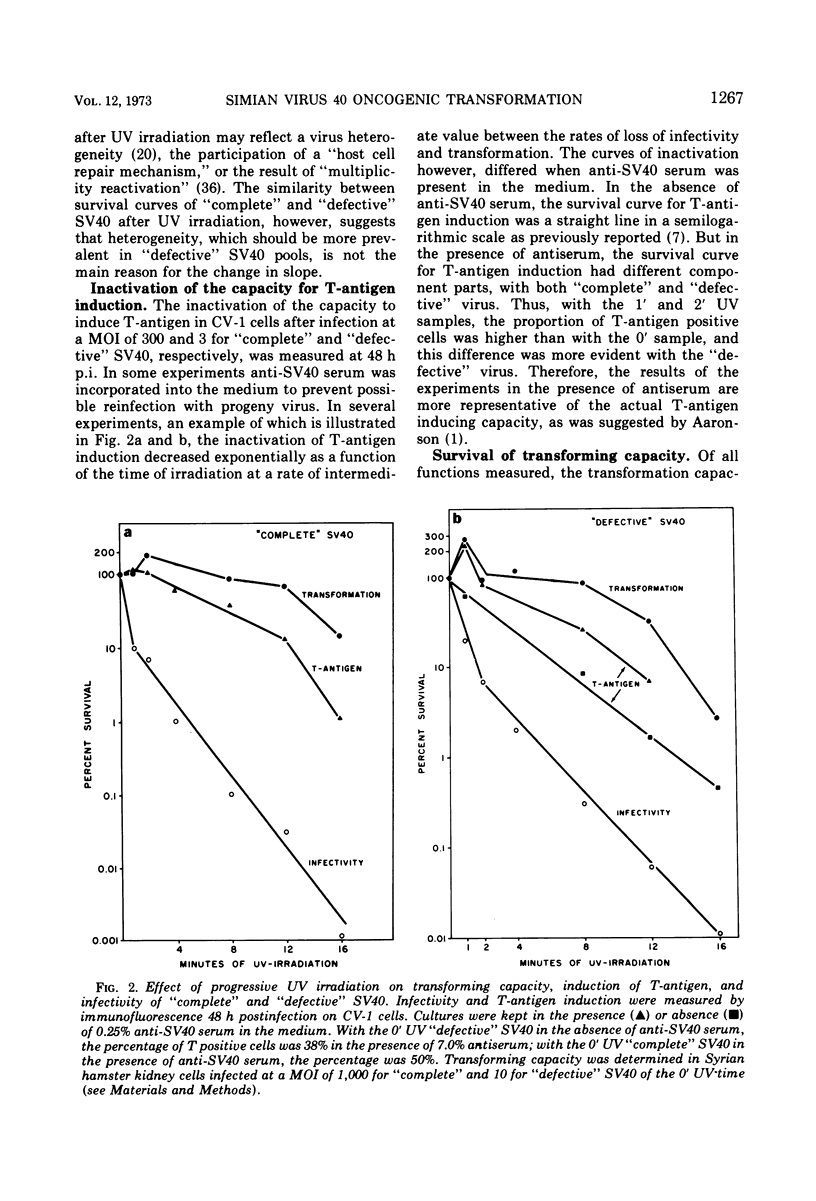
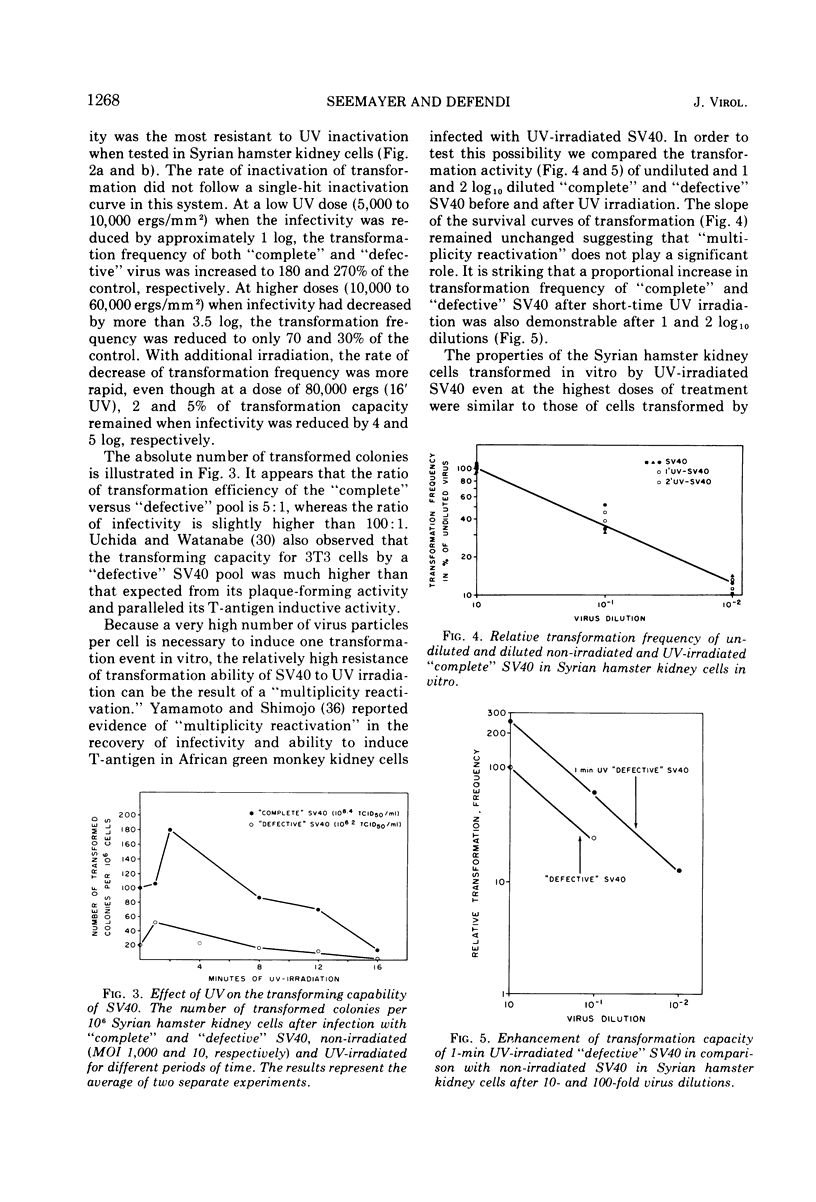
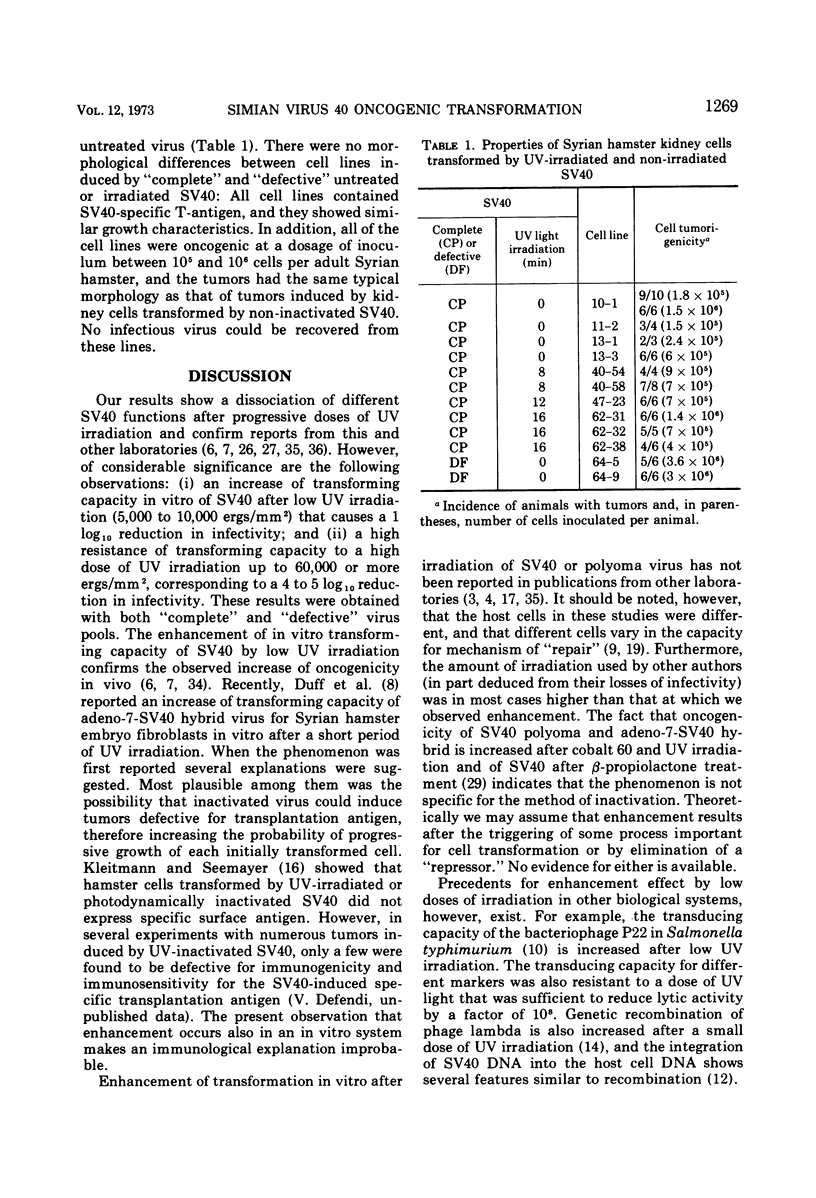
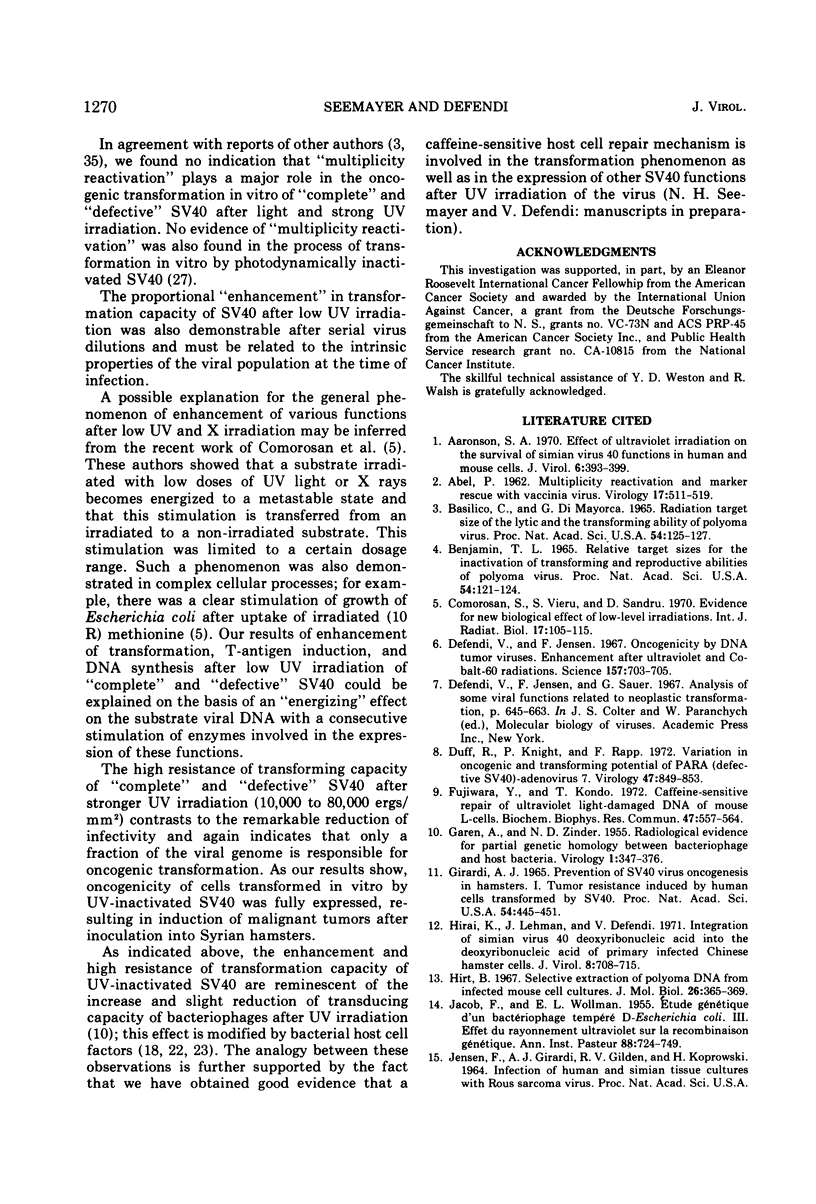
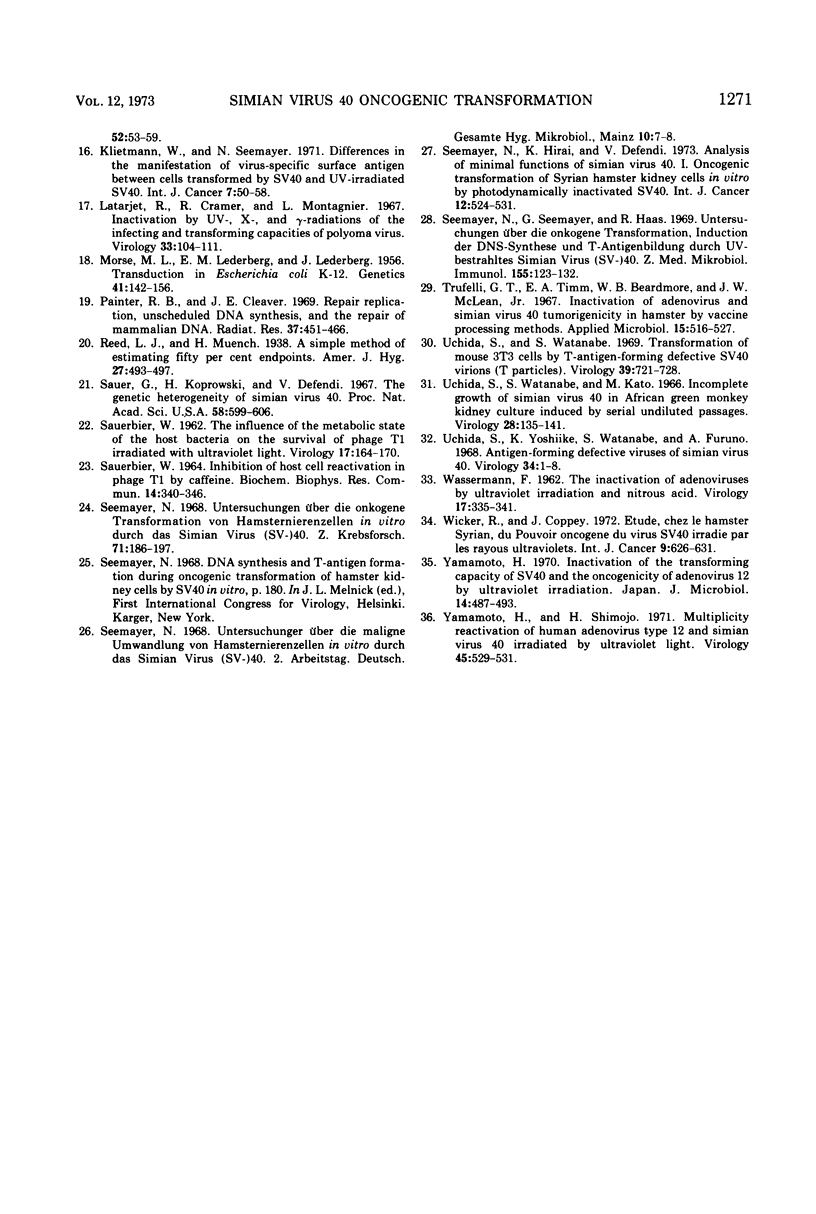
Selected References
These references are in PubMed. This may not be the complete list of references from this article.
- ABEL P. Multiplicity reactivation and marker rescue with vaccinia virus. Virology. 1962 Aug;17:511–519. doi: 10.1016/0042-6822(62)90150-2. [DOI] [PubMed] [Google Scholar]
- Aaronson S. A. Effect of ultraviolet irradiation on the survival of simian virus 40 functions in human and mouse cells. J Virol. 1970 Oct;6(4):393–399. doi: 10.1128/jvi.6.4.393-399.1970. [DOI] [PMC free article] [PubMed] [Google Scholar]
- Basilico C., Di Mayorca G. Radiation target size of the lytic and the transforming ability of polyoma virus. Proc Natl Acad Sci U S A. 1965 Jul;54(1):125–127. doi: 10.1073/pnas.54.1.125. [DOI] [PMC free article] [PubMed] [Google Scholar]
- Benjamin T. L. Relative target sizes for the inactivation of the transforming and reproductive abilities of polyoma virus. Proc Natl Acad Sci U S A. 1965 Jul;54(1):121–124. doi: 10.1073/pnas.54.1.121. [DOI] [PMC free article] [PubMed] [Google Scholar]
- Comorosan S., Vieru S., Sandru D. Evidence for a new biological effect of low-level irradiations. Int J Radiat Biol Relat Stud Phys Chem Med. 1970;17(2):105–115. doi: 10.1080/09553007014550151. [DOI] [PubMed] [Google Scholar]
- Defendi V., Jensen F. Oncogenicity by DNA tumor viruses: enhancement after ultraviolet and cobalt-60 radiations. Science. 1967 Aug 11;157(3789):703–705. doi: 10.1126/science.157.3789.703. [DOI] [PubMed] [Google Scholar]
- Duff R., Knight P., Rapp F. Variation in oncogenic and transforming potential of PARA (defective SV40)-adenovirus 7. Virology. 1972 Mar;47(3):849–853. doi: 10.1016/0042-6822(72)90579-x. [DOI] [PubMed] [Google Scholar]
- Fujiwara Y., Kondo T. Caffeine-sensitive repair of ultraviolet light-damaged DNA of mouse L cells. Biochem Biophys Res Commun. 1972 May 12;47(3):557–564. doi: 10.1016/0006-291x(72)90915-1. [DOI] [PubMed] [Google Scholar]
- GAREN A., ZINDER N. D. Radiological evidence for partial genetic homology between bacteriophage and host bacteria. Virology. 1955 Nov;1(4):347–376. doi: 10.1016/0042-6822(55)90030-1. [DOI] [PubMed] [Google Scholar]
- Girardi A. J. Prevention of SV40 virus oncogenesis in hamsters. I. Tumor resistance induced by human cells transformed by SV40. Proc Natl Acad Sci U S A. 1965 Aug;54(2):445–451. doi: 10.1073/pnas.54.2.445. [DOI] [PMC free article] [PubMed] [Google Scholar]
- Hirai K., Lehman J., Defendi V. Integration of simian virus 40 deoxyribonucleic acid into the deoxyribonucleic acid of primary infected Chinese hamster cells. J Virol. 1971 Nov;8(5):708–715. doi: 10.1128/jvi.8.5.708-715.1971. [DOI] [PMC free article] [PubMed] [Google Scholar]
- Hirt B. Selective extraction of polyoma DNA from infected mouse cell cultures. J Mol Biol. 1967 Jun 14;26(2):365–369. doi: 10.1016/0022-2836(67)90307-5. [DOI] [PubMed] [Google Scholar]
- JACOB F., WOLLMAN E. L. Etude génétique d'un bactériophage tempéré d'Escherichia coli. III. Effet du rayonnement ultraviolet sur la recombinaison génétique. Ann Inst Pasteur (Paris) 1955 Jun;88(6):724–749. [PubMed] [Google Scholar]
- Klietmann W., Seemayer N. Differences in the manifestation of virus-specific surface antigen between cells transformed by SV40 and UV-irradiated SV40. Int J Cancer. 1971 Jan 15;7(1):50–58. doi: 10.1002/ijc.2910070106. [DOI] [PubMed] [Google Scholar]
- Latarjet R., Cramer R., Montagnier L. Inactivation, by UV-, x-, and gamma-radiations, of the infecting and transforming capacities of polyoma virus. Virology. 1967 Sep;33(1):104–111. doi: 10.1016/0042-6822(67)90098-0. [DOI] [PubMed] [Google Scholar]
- Morse M L, Lederberg E M, Lederberg J. Transduction in Escherichia Coli K-12. Genetics. 1956 Jan;41(1):142–156. doi: 10.1093/genetics/41.1.142. [DOI] [PMC free article] [PubMed] [Google Scholar]
- Painter R. B., Cleaver J. E. Repair replication, unscheduled DNA synthesis, and the repair of mammalian DNA. Radiat Res. 1969 Mar;37(3):451–466. [PubMed] [Google Scholar]
- SAUERBIER W. The influence of the metabolic state of the host bacteria on the survival of phage T1 irradiated with ultraviolet light. Virology. 1962 May;17:164–170. doi: 10.1016/0042-6822(62)90093-4. [DOI] [PubMed] [Google Scholar]
- Sauer G., Koprowski H., Defendi V. The genetic heterogeneity of simian virus 40. Proc Natl Acad Sci U S A. 1967 Aug;58(2):599–606. doi: 10.1073/pnas.58.2.599. [DOI] [PMC free article] [PubMed] [Google Scholar]
- Sauerbier W. Inhibition of host cell reactivation in phage T1 by caffeine. Biochem Biophys Res Commun. 1964;14:340–346. doi: 10.1016/s0006-291x(64)80007-3. [DOI] [PubMed] [Google Scholar]
- Seemayer N. H., Hirai K., Defendi V. Analysis of minimal functions of simian virus 40. I. Oncogenic transformation of Syrian hamster kidney cells in vitro by photodynamically inactivated SV40. Int J Cancer. 1973 Sep 15;12(2):524–531. doi: 10.1002/ijc.2910120224. [DOI] [PubMed] [Google Scholar]
- Seemayer N., Seemayer G., Hass R. Untersuchungen über die onkogene Transformation, Induktion der DNS-Synthese und T-Antigenbildung durch UV-bestrahltes Simian Virus (SV-) 40. Z Med Mikrobiol Immunol. 1969;155(2):123–132. doi: 10.1007/BF02123856. [DOI] [PubMed] [Google Scholar]
- Seemayer N. Untersuchungen über die onkogene Transformation von Hamsternierenzellen in vitro durch das Simian Virus SV-40. Z Krebsforsch. 1968;71(2):186–197. doi: 10.1007/BF00524351. [DOI] [PubMed] [Google Scholar]
- Truffelli G. T., Timm E. A., Beardmore W. B., McLean I. W., Jr Inactivation of adenovirus and simian virus 40 tumorigenicity in hamsters by vaccine processing methods. Appl Microbiol. 1967 May;15(3):516–527. doi: 10.1128/am.15.3.516-527.1967. [DOI] [PMC free article] [PubMed] [Google Scholar]
- Uchida S., Watanabe S., Kato M. Incomplete growth of simian virus 40 in African green monkey kidney culture induced by serial undiluted passages. Virology. 1966 Jan;28(1):135–141. doi: 10.1016/0042-6822(66)90314-x. [DOI] [PubMed] [Google Scholar]
- Uchida S., Watanabe S. Transformation of mouse 3T3 cells by T antigen-forming defective SV40 virions (T particles). Virology. 1969 Dec;39(4):721–728. doi: 10.1016/0042-6822(69)90009-9. [DOI] [PubMed] [Google Scholar]
- WASSERMANN F. E. The inactivation of adenoviruses by ultraviolet irradiation and nitrous acid. Virology. 1962 Jun;17:335–341. doi: 10.1016/0042-6822(62)90124-1. [DOI] [PubMed] [Google Scholar]
- Wicker R., Coppey J. Etude, chez le hamster syrien, du pouvoir oncogène du virus SV 40 irradié par les rayons ultraviolets. Int J Cancer. 1972 May 15;9(3):626–631. doi: 10.1002/ijc.2910090320. [DOI] [PubMed] [Google Scholar]
- Yamamoto H. Inactivation of the transforming capacity of SV40 and the oncogenicity of adenovirus 12 by ultraviolet irradiation. Jpn J Microbiol. 1970 Nov;14(6):487–493. [PubMed] [Google Scholar]
- Yamamoto H., Shimojo H. Multiplicity reactivation of human adenovirus type 12 and simian virus 40 irradiated by ultraviolet light. Virology. 1971 Aug;45(2):529–531. doi: 10.1016/0042-6822(71)90355-2. [DOI] [PubMed] [Google Scholar]


